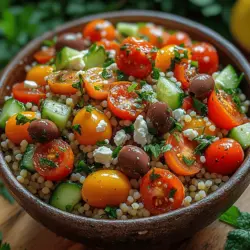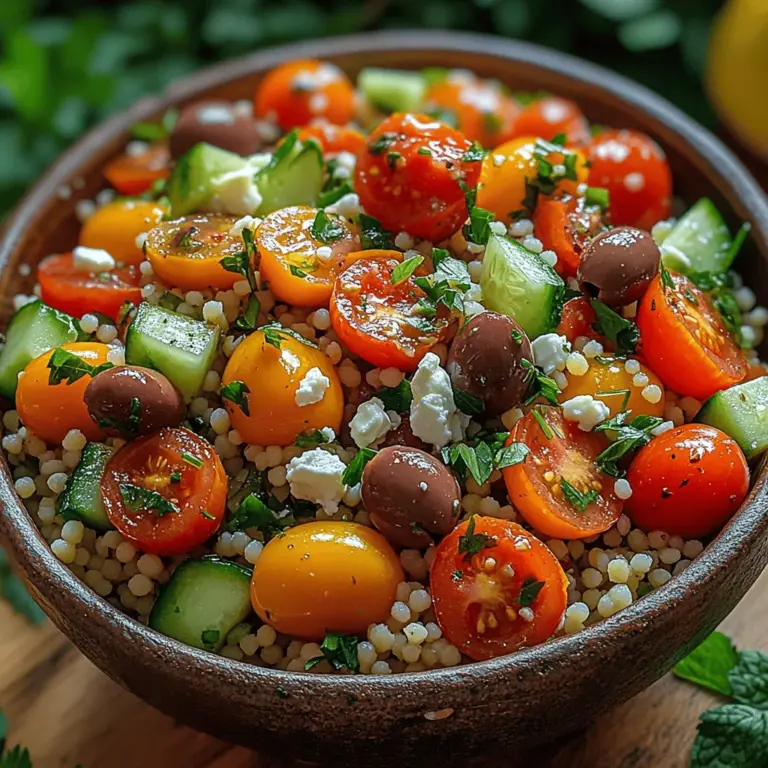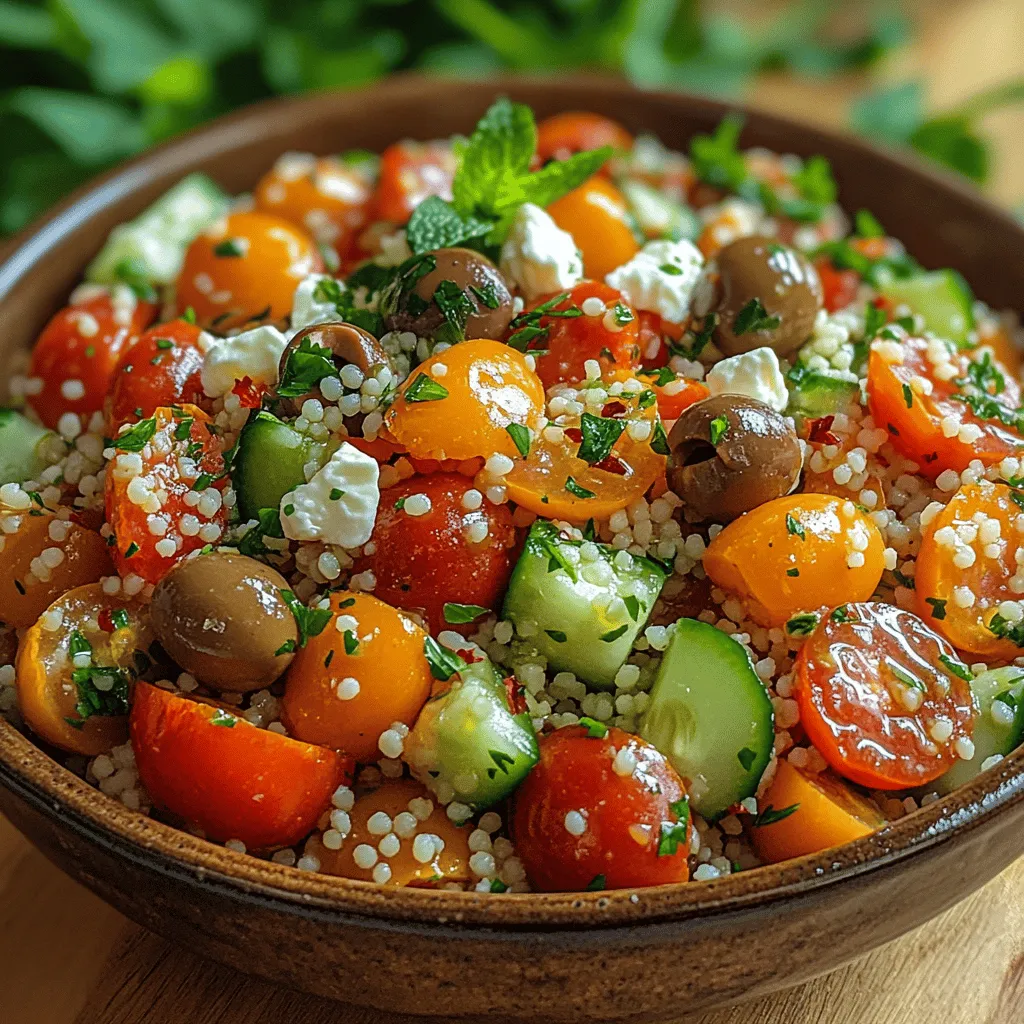Introduction
The Mediterranean Couscous Salad is a vibrant and nutritious dish that beautifully encapsulates the essence of Mediterranean cuisine. Bursting with fresh flavors and textures, this salad is not just a feast for the eyes but also a healthy option for those looking to indulge without guilt. With its colorful medley of vegetables, nutritious grains, and zesty dressing, it serves as a versatile dish that can be enjoyed as a side or a main course. Whether you’re hosting a summer gathering, packing a picnic lunch, or simply seeking a delightful addition to your weekday meals, this Mediterranean Couscous Salad is sure to impress.
At the heart of this recipe is couscous, a staple in Mediterranean cooking that not only provides a satisfying base but also brings along a wealth of nutritional benefits. The health-conscious will appreciate the high fiber content of the ingredients, which contribute to a balanced diet while enhancing digestion. Furthermore, the inclusion of fresh herbs, vegetables, and a light dressing elevates this salad into a refreshing choice that showcases the best of seasonal produce.
This recipe invites you to explore the delicious world of Mediterranean flavors, making each bite a celebration of health and taste. As you prepare this salad, you’ll discover how simple ingredients can come together to create a dish that is both satisfying and brimming with vitality.
Understanding Couscous: The Star Ingredient
Couscous is often hailed as the star ingredient of Mediterranean cuisine, and for good reason. This tiny, pasta-like grain is made from semolina flour and is believed to have originated in North Africa, with its popularity spreading throughout the Mediterranean region. Traditionally, couscous is steamed or boiled, resulting in a fluffy texture that serves as an excellent base for a variety of dishes.
Nutritionally, couscous is a powerhouse. It is rich in carbohydrates, providing a quick source of energy, while its high fiber content supports digestive health. Couscous is also relatively low in calories, making it a suitable choice for those mindful of their caloric intake. Additionally, it boasts a moderate amount of protein, contributing to a well-rounded meal when combined with vegetables and other protein sources.
When it comes to types of couscous, there are primarily two variations to consider: Moroccan and Israeli (also known as pearl couscous). Moroccan couscous consists of tiny granules and cooks very quickly, typically in just a few minutes. It is often used in salads, stews, and as a side dish. Israeli couscous, on the other hand, is larger and has a chewier texture, making it ideal for salads or as a heartier base for main dishes. Each type brings its unique characteristics to the table, allowing you to choose the one that best suits your culinary needs.
Ingredients Breakdown: Fresh and Flavorful Components
Creating a Mediterranean Couscous Salad requires a selection of fresh and vibrant ingredients that not only enhance the flavor but also add a range of nutrients. Below is a breakdown of the essential components that make this salad so appealing.
Couscous
As the base of the salad, couscous is the first ingredient you’ll need. Whether you opt for Moroccan or Israeli couscous, ensuring that you use high-quality grains is key to achieving the perfect texture. The couscous will absorb the flavors of the broth or water used during cooking, so it’s crucial to use a good quality vegetable broth or water for a more flavorful outcome.
Fresh Vegetables
The heart of this salad lies in its fresh vegetables. Here’s a look at some of the stars:
– Cherry Tomatoes: Sweet and juicy, cherry tomatoes add a burst of flavor and color. They are rich in vitamins C and K, antioxidants, and have been linked to numerous health benefits.
– Cucumber: Crisp and refreshing, cucumbers provide a hydrating element to the salad. They are low in calories and high in water content, making them a perfect addition for a light meal.
– Red Onion: Adding a slightly sharp flavor, red onions are not only flavorful but also rich in antioxidants and vitamins. When chopped finely, they blend beautifully with the other ingredients.
– Red Bell Pepper: Sweet and crunchy, red bell peppers add a delightful texture and vibrant color. They are packed with vitamins A and C, contributing to overall health.
Kalamata Olives and Feta Cheese
For depth and richness in flavor, Kalamata olives and feta cheese are essential. Kalamata olives provide a briny, savory taste that complements the freshness of the vegetables. They are also a source of healthy fats and antioxidants. Feta cheese adds creaminess and a slightly tangy profile, enhancing the overall flavor profile of the salad. Both ingredients work harmoniously to create a satisfying and flavorful dish.
Fresh Herbs
Herbs are critical to the Mediterranean flavor palette, and in this salad, parsley and mint play starring roles. Fresh parsley adds a bright, peppery note while mint contributes a refreshing touch. Both herbs not only enhance the flavor but also offer various health benefits, including anti-inflammatory properties and support for digestion.
Dressing: Olive Oil and Lemon Juice
The dressing for your Mediterranean Couscous Salad is simple yet effective. A combination of high-quality olive oil and fresh lemon juice serves as the perfect finish, binding the ingredients together while adding a zesty kick. Olive oil is rich in monounsaturated fats and antioxidants, promoting heart health, while lemon juice adds brightness and a dose of vitamin C. Together, they create a light yet flavorful dressing that elevates the salad to a new level.
Step-by-Step Preparation of Mediterranean Couscous Salad
Now that you have all your ingredients ready, it’s time to dive into the preparation process of your Mediterranean Couscous Salad. Follow these detailed steps to create a dish that is not only delicious but also visually stunning.
1. Cook the Couscous: Begin by bringing your vegetable broth or salted water to a boil in a medium saucepan. Once boiling, add the couscous, stirring gently to prevent clumping. Cover the pot, reduce the heat to low, and let it simmer for about 8-10 minutes, or until the couscous is tender and has absorbed the liquid. Fluff the couscous with a fork and let it cool.
2. Prepare the Vegetables: While the couscous is cooking, wash and chop your fresh vegetables. Halve the cherry tomatoes, dice the cucumber, finely chop the red onion, and dice the red bell pepper. Aim for uniform sizes to ensure an even distribution of flavors in each bite.
3. Combine Ingredients: In a large mixing bowl, combine the cooled couscous with the chopped vegetables, Kalamata olives, and crumbled feta cheese. Gently toss the ingredients together to mix evenly.
4. Make the Dressing: In a small bowl, whisk together the olive oil and lemon juice. Season the dressing with salt and pepper to taste. This simple dressing brings out the best in each ingredient.
5. Dress the Salad: Pour the dressing over the couscous and vegetable mixture. Toss gently to coat all the ingredients evenly. Be careful not to break up the feta too much; you want to keep some chunks for texture and flavor.
6. Add Fresh Herbs: Finally, fold in the chopped parsley and mint, reserving a small amount for garnish. The herbs will add an aromatic freshness that perfectly complements the other flavors.
7. Chill and Serve: Allow the salad to chill in the refrigerator for at least 30 minutes before serving. This resting time allows the flavors to meld beautifully. Just before serving, give it another gentle toss and garnish with the reserved herbs.
By following these steps, you’ll create a Mediterranean Couscous Salad that is not only a celebration of flavor but also a healthy option for any meal. The combination of fresh produce, hearty couscous, and a zesty dressing makes this salad a dish worth sharing. Whether enjoyed at a summer barbecue or as part of a weekday lunch, it is sure to become a favorite in your culinary repertoire.
Cooking the Couscous
Cooking couscous is a straightforward process that yields fluffy, flavorful grains perfect for salads. To start, bring a pot of vegetable broth to a boil. Using vegetable broth instead of water not only adds depth of flavor but also aligns with the Mediterranean theme, enhancing the overall taste profile of your salad. Once the broth reaches a rolling boil, remove the pot from heat and stir in the couscous, making sure it’s evenly distributed.
Cover the pot with a lid to trap the steam and allow the couscous to absorb the broth. Let it sit for about 5 minutes, or until the grains have expanded and absorbed all the liquid. After this resting period, use a fork to fluff the couscous gently, separating the grains to prevent clumping. It’s crucial to let the couscous cool to room temperature before combining it with the other salad ingredients. Cooling not only improves the texture but also allows the flavors to meld more effectively once combined with the fresh vegetables and dressing.
Preparing Fresh Vegetables
When it comes to the vegetables in your Mediterranean Couscous Salad, uniformity is key for both presentation and even flavor distribution. Start by selecting fresh, vibrant vegetables such as bell peppers, cucumbers, red onion, and cherry tomatoes. For efficient chopping, use a sharp knife to ensure clean cuts, which keeps the vegetables looking fresh and appealing.
1. Bell Peppers: Cut them in half, remove the seeds, and slice into thin strips before dicing into uniform small pieces.
2. Cucumbers: Peel if desired, then slice them in half lengthwise, scoop out the seeds with a spoon, and chop into bite-sized cubes.
3. Red Onion: Slice thinly and then chop to reduce the pungent flavor, making it milder and more palatable in the salad.
4. Cherry Tomatoes: Halve them to create visually appealing pops of color and bursts of juiciness in every bite.
By preparing your vegetables in this manner, not only do you enhance the aesthetic appeal of the salad, but you also ensure that every forkful contains a balanced mix of flavors and textures.
Crafting the Dressing
The dressing for your Mediterranean Couscous Salad is where you can truly elevate the dish. A well-crafted dressing should balance acidity, sweetness, and savory notes. A classic Mediterranean dressing typically consists of olive oil, lemon juice, garlic, salt, and pepper. To make the dressing, whisk together 1/4 cup of extra virgin olive oil with the juice of one large lemon. Add in one minced garlic clove, a pinch of salt, and freshly ground black pepper to taste.
For added depth, consider incorporating a teaspoon of honey or maple syrup to introduce a touch of sweetness that complements the acidity of the lemon. Additionally, you can experiment with different herbs such as fresh parsley, oregano, or basil to give your dressing a personalized twist. If you prefer a creamier dressing, a dollop of Greek yogurt can create a rich consistency that pairs beautifully with the couscous and vegetables.
Combining Ingredients
Once your couscous has cooled and your vegetables are prepped, it’s time to bring everything together. In a large mixing bowl, combine the cooled couscous with the chopped vegetables. Drizzle your prepared dressing over the top, and gently toss the mixture with a spatula or wooden spoon. Be careful not to overmix as you want to maintain the integrity of the vegetables while ensuring an even coating of dressing throughout the salad.
For optimal flavor distribution, consider letting the salad sit for about 10-15 minutes after tossing, allowing the couscous to absorb the dressing and the flavors to meld. This resting period is essential for maximizing taste and creating a cohesive dish.
Chilling the Salad
Chilling your Mediterranean Couscous Salad is not just about temperature; it’s about flavor enhancement. By allowing the salad to chill for at least 30 minutes in the refrigerator before serving, the coolness of the salad becomes refreshing, making it perfect for warm weather gatherings or as a light lunch option. Moreover, this chilling period lets the dressing penetrate the grains and vegetables, intensifying the overall flavor profile of the dish.
For best results, cover the salad with plastic wrap or a lid to keep it fresh. When ready to serve, give it a quick toss to redistribute any settled dressing before plating.
Serving Suggestions and Pairings
The versatility of Mediterranean Couscous Salad makes it an excellent addition to any meal. Here are a few serving suggestions to consider:
– As a Side Dish: Serve the salad alongside grilled meats like chicken, lamb, or seafood. The bright flavors and refreshing textures of the couscous salad complement the savory elements of grilled dishes wonderfully.
– As a Main Course: Transform the salad into a hearty main by adding protein-rich options like grilled chicken, shrimp, or chickpeas. This not only enhances the nutritional profile of the dish but also keeps you satisfied for longer.
– Customizing the Salad: Take advantage of seasonal produce by incorporating vegetables like roasted zucchini, asparagus, or even corn for a different flavor and texture. Additionally, experiment with various dressings, such as a balsamic vinaigrette or tahini dressing, to suit your palate.
Health Benefits of Mediterranean Cuisine
The Mediterranean diet is celebrated for its health benefits, emphasizing whole foods, healthy fats, and an abundance of fresh produce. The ingredients in your Mediterranean Couscous Salad contribute significantly to heart health, thanks to the healthy fats found in olive oil and the abundance of vegetables rich in vitamins, minerals, and antioxidants.
The high fiber content from the couscous and vegetables helps with weight management and promotes digestive health. Furthermore, incorporating more plant-based meals, such as this salad, into your diet can lead to improved overall well-being. The combination of nutrient-dense ingredients works to lower cholesterol, reduce inflammation, and provide sustained energy levels.
Conclusion
The Mediterranean Couscous Salad is not just a dish; it’s an experience that brings together vibrant flavors, healthy ingredients, and ease of preparation. Whether served as a refreshing side at a summer barbecue, a main course for a vegetarian delight, or customized to suit your preferences, this salad is adaptable to various occasions and dietary needs.
With its myriad health benefits and delicious taste, it’s a fantastic addition to any meal plan. Embrace the refreshing flavors of the Mediterranean by giving this couscous salad a try, and enjoy the burst of taste and nutrition it brings to your table.


